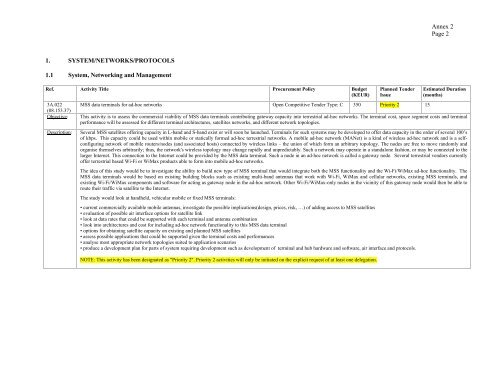ARTES-5.1 â ESA Telecom Technology Workplan ... - Emits - ESA
ARTES-5.1 â ESA Telecom Technology Workplan ... - Emits - ESA
ARTES-5.1 â ESA Telecom Technology Workplan ... - Emits - ESA
- No tags were found...
Create successful ePaper yourself
Turn your PDF publications into a flip-book with our unique Google optimized e-Paper software.
Annex 2Page 21. SYSTEM/NETWORKS/PROTOCOLS1.1 System, Networking and ManagementRef. Activity Title Procurement Policy Budget(KEUR)3A.022(08.153.37)Objective:Planned TenderIssueMSS data terminals for ad-hoc networks Open Competitive Tender Type: C 350 Priority 2 15Estimated Duration(months)This activity is to assess the commercial viability of MSS data terminals contributing gateway capacity into terrestrial ad-hoc networks. The terminal cost, space segment costs and terminalperformance will be assessed for different terminal architectures, satellites networks, and different network topologies.Description: Several MSS satellites offering capacity in L-band and S-band exist or will soon be launched. Terminals for such systems may be developed to offer data capacity in the order of several 100’sof kbps. This capacity could be used within mobile or statically formed ad-hoc terrestrial networks. A mobile ad-hoc network (MANet) is a kind of wireless ad-hoc network and is a selfconfiguringnetwork of mobile routers/nodes (and associated hosts) connected by wireless links – the union of which form an arbitrary topology. The nodes are free to move randomly andorganise themselves arbitrarily; thus, the network's wireless topology may change rapidly and unpredictably. Such a network may operate in a standalone fashion, or may be connected to thelarger Internet. This connection to the Internet could be provided by the MSS data terminal. Such a node in an ad-hoc network is called a gateway node. Several terrestrial vendors currentlyoffer terrestrial based Wi-Fi or WiMax products able to form into mobile ad-hoc networks.The idea of this study would be to investigate the ability to build new type of MSS terminal that would integrate both the MSS functionality and the Wi-Fi/WiMax ad-hoc functionality. TheMSS data terminals would be based on existing building blocks such as existing multi-band antennas that work with Wi-Fi, WiMax and cellular networks, existing MSS terminals, andexisting Wi-Fi/WiMax components and software for acting as gateway node in the ad-hoc network. Other Wi-Fi/WiMax-only nodes in the vicinity of this gateway node would then be able toroute their traffic via satellite to the Internet.The study would look at handheld, vehicular mobile or fixed MSS terminals:• current commercially available mobile antennas, investigate the possible implications(design, prices, risk, …) of adding access to MSS satellites• evaluation of possible air interface options for satellite link• look at data rates that could be supported with each terminal and antenna combination• look into architectures and cost for including ad-hoc network functionality to this MSS data terminal• options for obtaining satellite capacity on existing and planned MSS satellites• assess possible applications that could be supported given the terminal costs and performances• analyse most appropriate network topologies suited to application scenarios• produce a development plan for parts of system requiring development such as development of terminal and hub hardware and software, air interface and protocols.NOTE: This activity has been designated as "Priority 2". Priority 2 activities will only be initiated on the explicit request of at least one delegation.
















